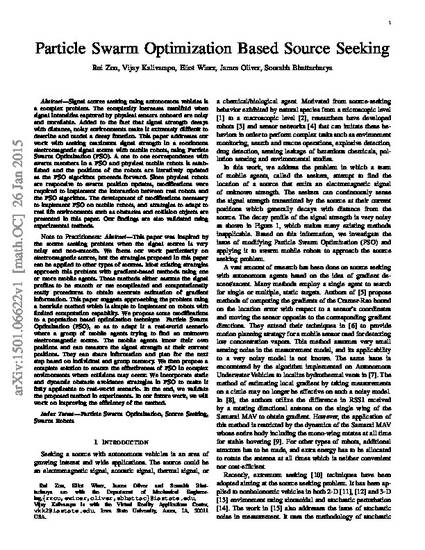
The task of locating a source based on the measurements of the signal emitted/emanating from it is called the source-seeking problem. In the past few years, there has been a lot of interest in deploying autonomous platforms for source-seeking. Some of the challenging issues with implementing autonomous source-seeking are the lack of a priori knowledge about the distribution of the emitted signal and presence of noise in both the environment and on-board sensor measurements. This paper proposes a planner for a swarm of robots engaged in seeking an electromagnetic source. The navigation strategy for the planner is based on Particle Swarm Optimization (PSO) which is a population-based stochastic optimization technique. An equivalence is established between particles generated in the traditional PSO technique, and the mobile agents in the swarm. Since the positions of the robots are updated using the PSO algorithm, modifications are required to implement the PSO algorithm on real robots to incorporate collision avoidance strategies. The modifications necessary to implement PSO on mobile robots, and strategies to adapt to real environments are presented in this paper. Our results are also validated on an experimental testbed. Note to Practitioners-This paper is inspired by the source seeking problem in which the signal emitted from the source is assumed to be very noisy, and the spatial distribution is assumed to be non-smooth. We focus our work specifically on electromagnetic sources. However, the strategies proposed in this paper are also applicable to other kinds of sources, for example, nuclear, radiological, chemical or biological. We develop a planner for a swarm of mobile agents that try to locate an unknown electromagnetic source. The mobile agents know their own positions and can measure the signal strength at their current location. They can share information among themselves, and plan for the next step. We propose a complete solution to ensure the effectiveness of PSO in complex environments where collisions may occur. We incorporate static and dynamic obstacle avoidance strategies in PSO to make it fully applicable to real-world scenario. We validate the proposed technique on an experimental testbed. As a part of our future work, we will extend the technique to locate multiple sources of different kinds.
Available at: http://works.bepress.com/james_oliver/60/

This is a manuscript of an article published as Zou, Rui, Vijay Kalivarapu, Eliot Winer, James Oliver, and Sourabh Bhattacharya. "Particle swarm optimization-based source seeking." IEEE Transactions on Automation Science and Engineering 12, no. 3 (2015): 865-875. doi: 10.1109/TASE.2015.2441746. Posted with permission.